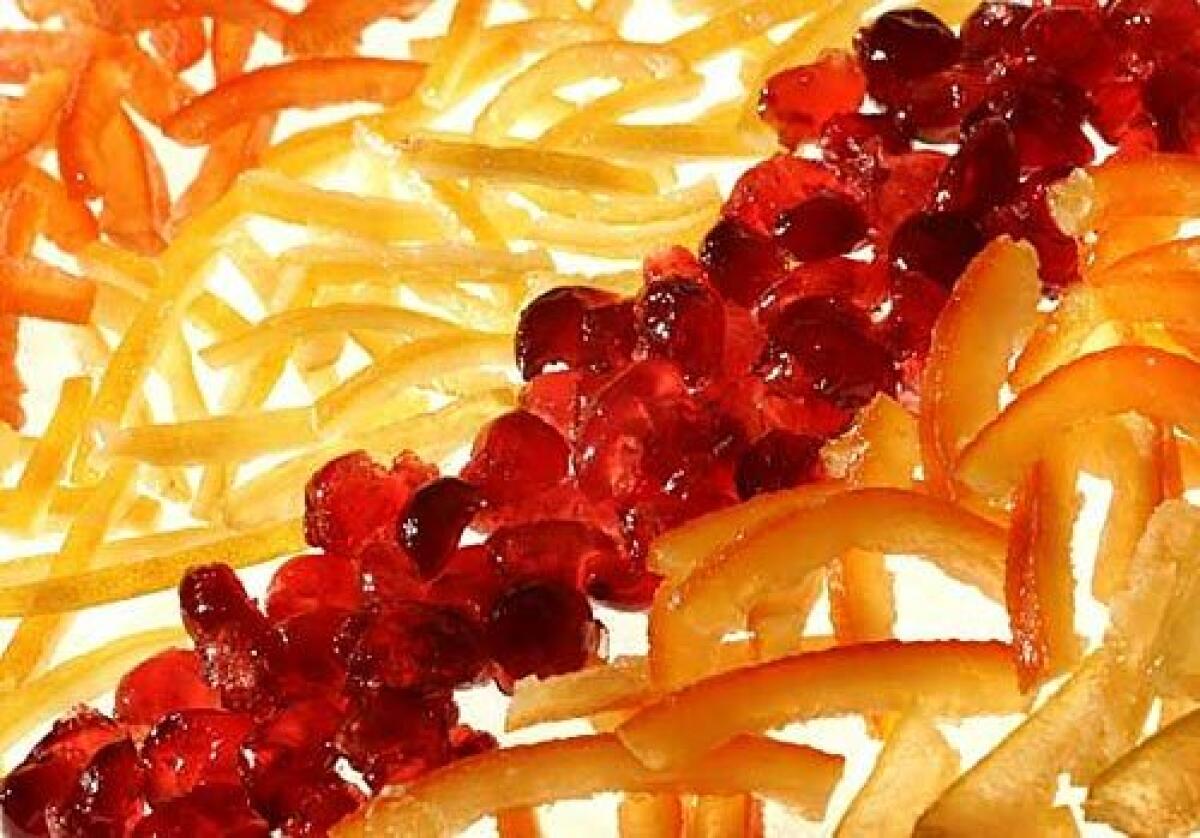Panettone and stollen, a pair of European dandies

- Share via
DURING the Christmas season, we bake. We bake rich, show-offy treats for big parties and once-a-year gatherings. But we also bake for the quiet moments, the times that will become treasured memories. And there’s nothing better to offer with that early morning cup of coffee you pour for a visiting relative or to slip into a hungry child’s hand than a slice of panettone or stollen -- fragrant, yeasty holiday breads that are festive just to look at and sweetly satisfying to eat.
These European classics, though available in commercial versions, have an understated elegance when updated and made from scratch with homemade candied citrus peel, spirit-soaked dried fruits, and festive touches such as glacé cranberries. Although their different shapes and textures suggest otherwise, panettone (tall and light) and stollen (long and dense) are made from a basic butter- and sugar-enriched yeast dough. Panettone typically contains candied orange peel and raisins; traditional stollen had candied lemon peel and dried cherries as well. The extra fruit and sometimes even a layer of marzipan, plus added milk and flour, contribute to the compact shape of classic stollen versus the loftier panettone.
Candied citrus peel, glacé cranberries and spirit-soaked fruits are easy to make, but require some advance planning as well as, for the peel, overnight drying time. For mixed peels, select two or more varieties of the wonderful citrus in the farmers markets this season -- California navel oranges, Meyer lemons, pink grapefruits and pomelos. Look for the most vibrant colors.
Carefully remove the skins, keeping the pith attached, and blanch the peels three times in boiling water to remove bitterness. Simmer different varieties of citrus rind in different pots of simple syrup (so that the flavors remain distinct) until they are semitransparent, one to two hours, and dry overnight. Pomelo rinds, which are porous, cook more quickly than other citrus peels, and should be done in about an hour. Meanwhile, for making stollen, simmer handfuls of firm, bright cranberries in another pot of simmering syrup.
Plumping the dried and candied fruits in spirits for a half-hour or hour allows the flavors of the fruit to infuse the spirits and permeate the dough. Don’t omit tiny touches such as fresh vanilla bean and two varieties of raisins for the panettone, or more than one kind of peel for the stollen -- the elegance is in the details.
To make the panettone, mix, knead and allow the bread its first rising while the fruit soaks, then punch down the dough and add the rum-soaked raisins and candied orange peel. Bake the panettone in free-standing panettone liners (like large muffin-tin liners) instead of pans.
A fragrant combination of orange, Meyer lemon, grapefruit and pomelo rind is fantastic for the stollen, but any combination is wonderful. While the fruit soaks, mix and knead the dough, then work in the dried and candied fruits and let the dough rise. Meanwhile, roll marzipan (sweet almond paste) into ropes, two for each loaf of stollen. Shape the risen dough into two large ovals, place the ropes in the middle of each oval and fold the dough’s edges over the marzipan. Taper and pinch the ends and allow the dough to rise again before baking.
Delicious when freshly baked, these citrusy sweet loaves are also delightful if the flavors mellow for several days. Either way, they’re beautiful gifts worth keeping around this holiday.
More to Read
Eat your way across L.A.
Get our weekly Tasting Notes newsletter for reviews, news and more.
You may occasionally receive promotional content from the Los Angeles Times.







